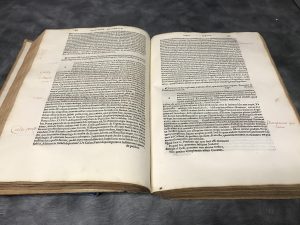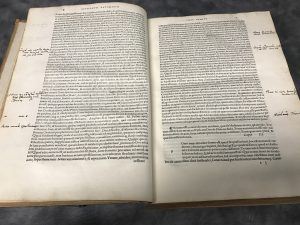Background
Donated by Dr. Leslie Poste in 1980, Sicuti Antiquarum Lectionum is the oldest book in Milne Library’s Special Collections at SUNY Geneseo. Published in Venice, Italy in 1516, this book is categorized at Milne Library as a Latin encyclopedia. The actual title for this book is so long that it would never be referred to in its entirety, so we settle for the first three words, loosely translated to be As in Past Lessons.
This book was written by Lodovicus Caelius Rhodiginus, a Venetian writer who specialized in Greek and Latin. The general sense of his book it is a collection of notes and commentaries on classic literature, philosophy, and theology, among other topics. Rhodiginus’s encyclopedia was one of many that passed through the hands of Dr. Poste, so while I don’t believe it had a particularly profound influence on him, I think it is a good representation of his life as a preserver of European libraries and as a rare book dealer. This book was produced in the same year that the city officially established a Jewish ghetto known as the Venetian Ghetto, which legally instituted political restrictions on Jewish rights. Often in the Middle Ages, Latin was used in scholarly circles as means to exclude groups of people, particularly the poor and uneducated, which situates this book neatly in this time period as an educational book written exclusively in Latin.

The title page of Sicuti shows an interesting mark that is known as the signature of the Venetian printing press in which this book was produced: a symbol of a dolphin wrapping itself around an anchor (Fig. 1). This is the character used to denote that a work was published by Aldus Manutius, a famed printer/publisher of the late 15th and early 16th century. Aldus founded the Venetian printing/publishing company known as Aldine Press, which led Europe in its innovative techniques. His death in 1515 rules out his own personal hand being involved in the production of this Rhodiginus’s 1516 text, but his methods were clearly being carried out by his followers as they not only used his mark, but also displayed a similar craftsmanship for which Aldus made himself a name. Notice how the lengthy title is printed as an inverted triangle; not an easy feat during the hand-press era.
While an antiquarian bibliophile may be able to access this book online or even through other libraries, the copy given by Dr. Poste to Milne Library has its own unique qualities and characteristics that make it a worthwhile bibliographic specimen. Continue navigating this page to learn about the features specific to Milne Library’s copy of Sicuti Antiquarum Lectionum!
Origin
While this copy of Sicuti Antiquarum Lectionum was donated by Dr. Poste in 1980, notice the additional bookplate on the inside cover: “Amherst College Library.” Beneath its artistic representation of Socrates, the bookplate also notes that it was “discarded” by Amherst College Library, although there is no clear indication of exactly when this happened.
Binding
The binding on Milne’s copy of Sicuti Antiquarum Lectionum is certainly not original. This copy was likely rebound long ago, however, as even today its cover is no longer fully attached. Refer back to the video from How It’s Made to learn more about what rebinding entails, and then notice the qualities of rebinding posses by this book: the cloth along the spine, the neatly trimmed paper edges, and the cover anachronistic to 16th century binding.
Marginalia
As with both of the other Latin texts in Poste’s donation, this book is interestingly annotated in both Latin and Italian script. While my own Italian and Latin is a bit rusty, I am at least able to appreciate the beauty of the notations, if not completely understand their meaning. Interestingly enough, there are multiple instances of such marginalia in Sicuti Antiquarum Lectionum, and, judging by the handwriting, I would contend that they are from different readers, one in black ink and another in red (Fig. 2 and Fig. 3, respectively).


Watermarks
Interact with these Juxtapose JS images by sliding the dividing white line from left to right to reveal the hidden image of the watermark! Notice the difference in the placement and image used for the watermark in the first juxtaposition. While watermarks on the center of the page indicate a folio format (the larger sheet was only folded once to create a signature) the watermark closer to the inner binding might indicate a different kind of format, and definitely indicates the use of a different set of paper than what was used for the rest of the book.
“Aldus Manutius,” Encyclopædia Brittanica, accessed May 5, 2017, https://www.britannica.com/biography/Aldus-Manutius.
All photos by Amanda Wentworth.



